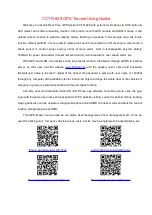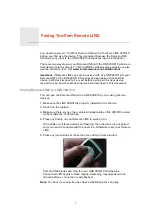
www.javad.com
107
Coordinate Systems
visualization include distortions (namely mapping angles,
2
nd
term corrections, scale factors and elevation factors).
J-Field
balances the need for flat Earth calculations, for
the user and accurate Geodetic point storage by storing
points internally as Latitude, Longitude and Ellipsoid
Height, (LLH) and transforming coordinates on-the-fly
to any projection desired. To the user, with a State Plane
Coordinate System set for the project, this transformation is
entirely transparent. The user sees State Plane Coordinates,
can export State Plane Coordinates and can import
State Plane Coordinates, while never actually seeing the
internal database coordinates that are LLH. This scheme
simultaneously provides a comfortable user interface and
geodetic purity in the software, unprecedented in previous
field software.
In the early days of precise geodetic positioning several
reference frames were developed - in North America the
most common being the World Geodetic System of 1984
(WGS84) and the North American Datum of 1983 (NAD83).
Initially these systems were thought to be nearly identical,
but with the refinement of measurements over time, it has
been determined that the difference in the position of the
center of mass of the Earth (or origin) for NAD83 and for
WGS84 is separated by approximately 2 meters with slight
axes rotations and scale difference. WGS84 is the coordinate
system of the Global Positioning System which is maintained
by the US Department of Defense, and the realization (the
actual physical points with coordinate values) is classified,
however the International Earth Rotation and Reference
System Service (IERS) has, by observation, developed the
International Terrestrial Reference Frame (ITRF) which is
understood to be equivalent to WGS84. Based on further
long term observations it has become possible to develop
precise transformation between WGS84 (or more specifically
ITRF2008) and the North American Datum of 1983 (NAD83).
From direct comparisons of ITRF08 and NAD83, geodesists
have developed and continue to refine a 14 parameter
transformation that computes the difference between the
systems in X,Y,Z, rotation of X, rotation of Y, rotation of Z,
and scale. These are seven of the 14 parameters.
WGS84 also differs from NAD83 in that the US National
Geodetic Survey goes to great lengths to keep the NAD83
reference frame relative to the North American Tectonic
Plate. This allows NAD83 coordinates to change very little
over time, based only on improved positioning accuracy
and regional and local ground movements. This requires
velocities of points across North America to be meticulously
generated to relate this seemingly static reference frame
(which is actually moving at a rate of a couple of centimeters
per year) to the center of mass of the Earth.
Summary of Contents for TRIUMPH-LS
Page 1: ...U S E R S G U I D E TO T H E T R I U M P H L S E Version 20160121 ...
Page 17: ...www javad com 17 Introduction ...
Page 39: ...www javad com 39 Collect Screens ...
Page 59: ...www javad com 59 Stake Out Points ...
Page 91: ...www javad com 91 Stake Out Alignments ...
Page 93: ...www javad com 93 Using ShapeTags and Codes Data Structure ...
Page 105: ...www javad com 105 Using ShapeTags and Codes ...
Page 149: ...www javad com 149 Localization ...
















































